
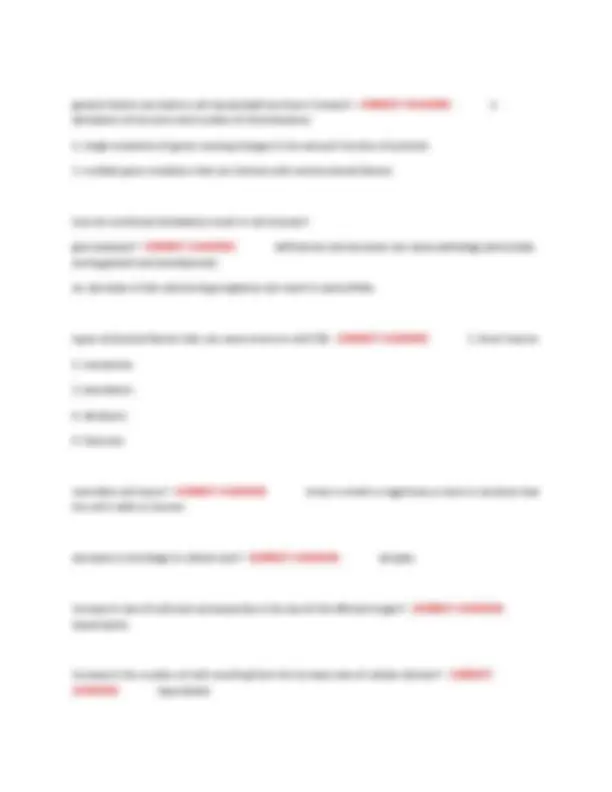
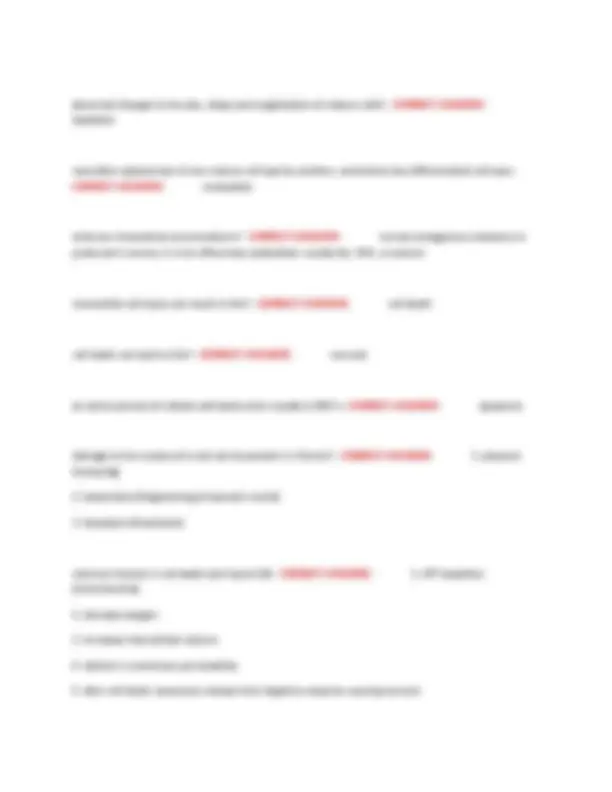
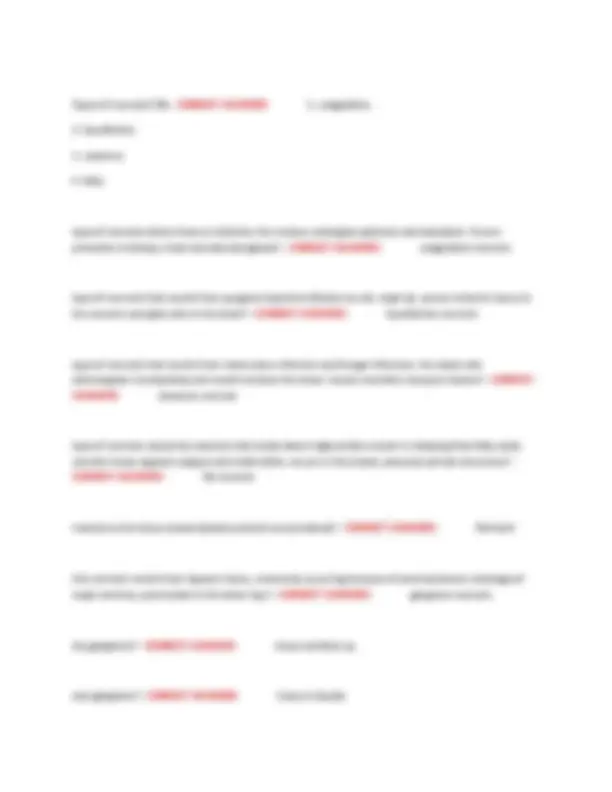
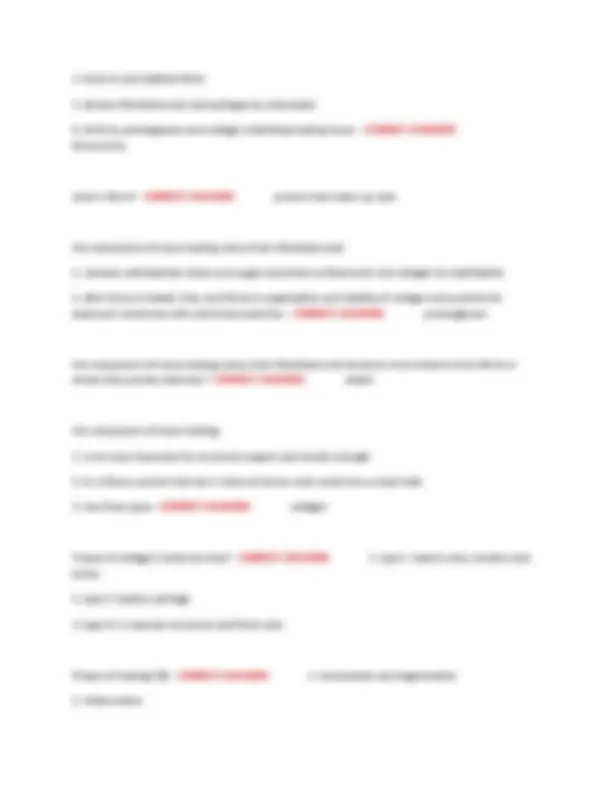
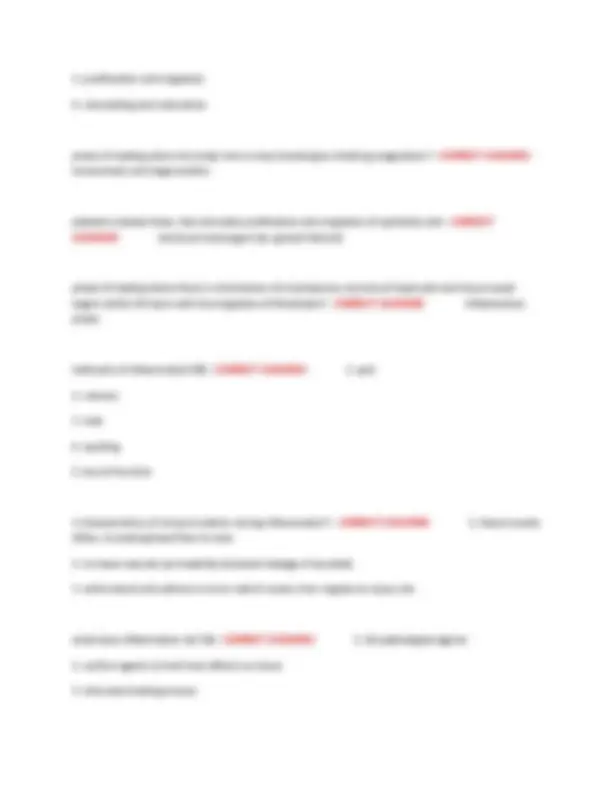
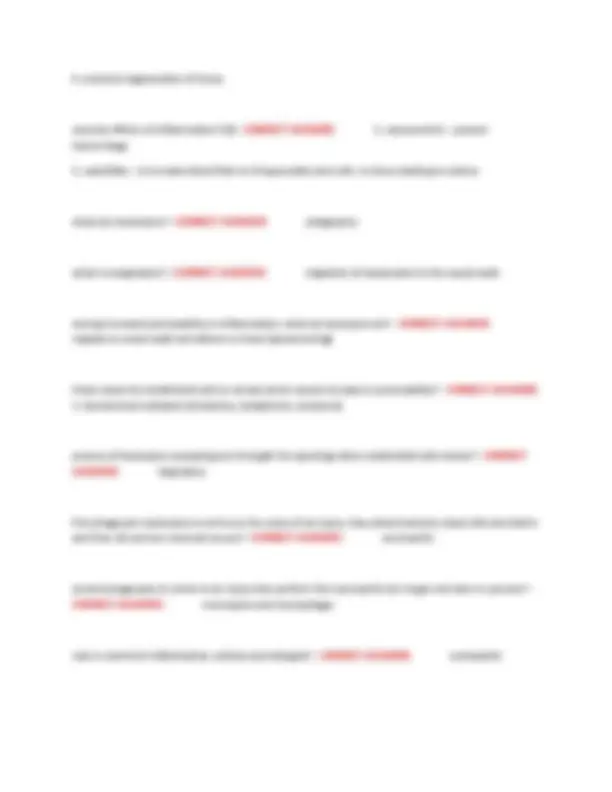
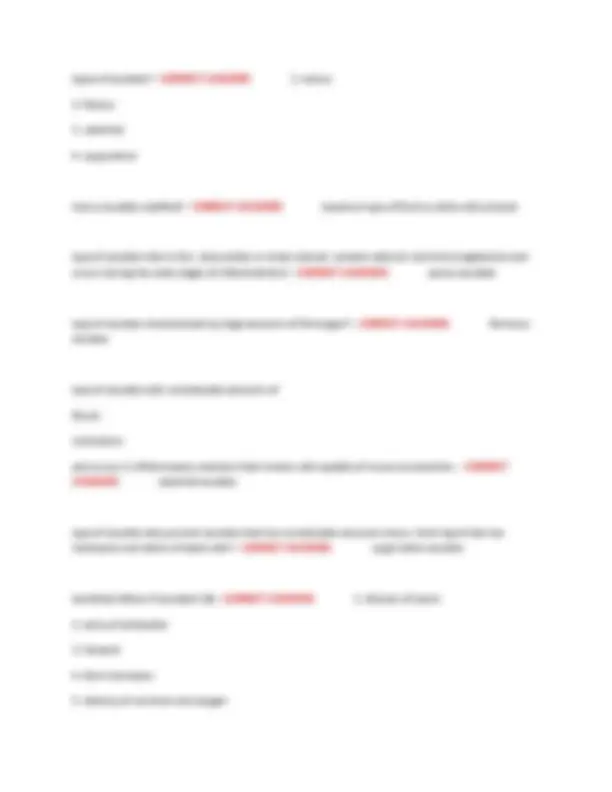
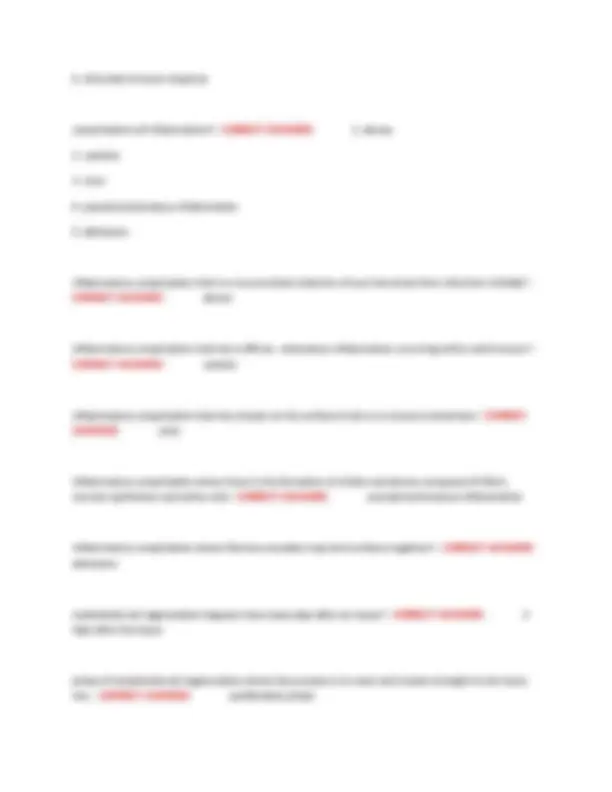
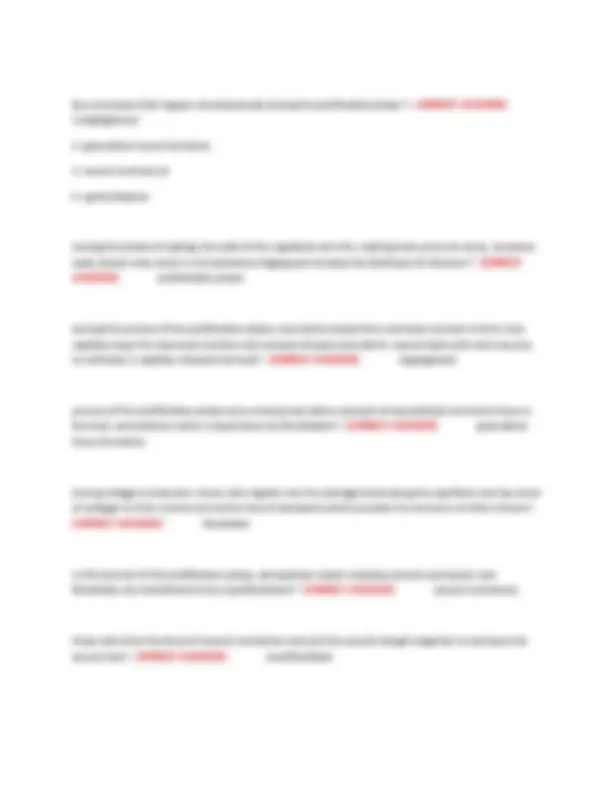


Study with the several resources on Docsity

Earn points by helping other students or get them with a premium plan


Prepare for your exams
Study with the several resources on Docsity

Earn points to download
Earn points by helping other students or get them with a premium plan
Community
Ask the community for help and clear up your study doubts
Discover the best universities in your country according to Docsity users
Free resources
Download our free guides on studying techniques, anxiety management strategies, and thesis advice from Docsity tutors
Pathology Exam 1 Exam Questions with Complete Solutions (Latest 2025).
Typology: Exams
1 / 17

This page cannot be seen from the preview
Don't miss anything!










stressors to cells? (7) - CORRECT ANSWERS 1. ischemia
reversing cell injury depends on? (6) - CORRECT ANSWERS 1. type, severity and duration of injury
ischemia? - CORRECT ANSWERS lack of blood flow
these are responsible for the vast majority of infections? (2) - CORRECT ANSWERS 1. bacteria
mechanisms of infectious diseases depends on ability to? (3) - CORRECT ANSWERS 1. invade and destroy cells
bacteria releases these _____ that cause cell lysis? - CORRECT ANSWERS 1. endotoxins
when microorganisms or their toxins are present in blood? - CORRECT ANSWERS sepsis
Viruses kill cells by these two mechanisms? - CORRECT ANSWERS 1. direct cytopathic effect (RNA viruses)
viruses use this mechanism to:
disturb the cellular processes of the nucleus and/or plasma membrane. Virally encoded proteins become inserted in the membrane, altering permeability. - CORRECT ANSWERS Direct cytopathic effect (RNA viruses)
viruses use this mechanism to integrate themselves into cellular genome producing foreign proteins? - CORRECT ANSWERS indirect cytopathic effect (DNA viruses)
mechanisms by which the immune system can lead to cell injury or death? (3) - CORRECT ANSWERS
normally the immune system fights against disease, but can sometimes become overzealous and can lead to? - CORRECT ANSWERS hypersensitivity reactions
allergens have a high level of this? - CORRECT ANSWERS antibody (IgE)
abnormal changes in the size, shape and organization of mature cells? - CORRECT ANSWERS dysplasia
reversible replacement of one mature cell type by another, sometimes less differentiated cell type - CORRECT ANSWERS metaplasia
what are intracellular accumulations? - CORRECT ANSWERS normal endogenous substance is produced in excess, it is not effectively catabolized. usually fat, CHO, or protein
irreversible cell injury can result in this? - CORRECT ANSWERS cell death
cell death can lead to this? - CORRECT ANSWERS necrosis
an active process of cellular self-destruction usually in RBC's - CORRECT ANSWERS apoptosis
damage to the nucleus of a cell can be present in 3 forms? - CORRECT ANSWERS 1. pkynosis (clumping)
common themes in cell death and injury? (5) - CORRECT ANSWERS 1. ATP depletion (mitochondria)
Types of necrosis? (4) - CORRECT ANSWERS 1. coagulative
type of necrosis where there is ischemia. the nucleus undergoes pyknosis and karyolysis. Occurs primarily in kidneys, heart and adrenal glands? - CORRECT ANSWERS coagulative necrosis
type of necrosis that results from pyogenic bacteria infection (e.coli, staph a), causes ischemic injury to the neurons and glial cells in the brain? - CORRECT ANSWERS liquefactive necrosis
type of necrosis that results from tuberculous infection and fungai infections. the dead cells disintergrate incompletely and a wall encloses the areas. tissues resemble clumped cheese? - CORRECT ANSWERS casseous necrosis
type of necrosis caused by enzymes that break down triglycerides results in releasing free fatty acids. necrotic tissue appears opaque and chalk white. occurs in the breast, pancreas and ab structures? - CORRECT ANSWERS fat necrosis
trauma to the tissue vessels (plasma protein accumulates)? - CORRECT ANSWERS fibrinoid
this necrosis results from hypoxic injury, commonly occurring because of arteriosclerosis, blockage of major arteries, particularly in the lower leg.? - CORRECT ANSWERS gangrene necrosis
dry gangrene? - CORRECT ANSWERS tissue wrinkles up
wet gangrene? - CORRECT ANSWERS tissue is liquidy
levels of the rancho los amigos scale where the pt focuses on skills necessary to reenter the community?
why are fractures immobilized after the injury? - CORRECT ANSWERS to allow phagocytic removal of necrotic bone and fibrocartilageonous callus.
what are the highest risk of death in the hours after myocardial infarction? - CORRECT ANSWERS dysrhythmias
why is exercise or excessive stress after a MI bad? - CORRECT ANSWERS possible rupture of the myocardium during days 3-
regrowth of original tissue? - CORRECT ANSWERS regeneration
formation of connective tissue scar? - CORRECT ANSWERS repair
following an injury, inflammation cells are recruited from blood circulation and begin healing by? - CORRECT ANSWERS breaking down and removing necrotic tissue
components of tissue healing? - CORRECT ANSWERS 1. fibronectin
this component of tissue healing:
what is fibrin? - CORRECT ANSWERS protein that makes up clots
this component of tissue healing comes from fibroblasts and:
this component of tissue healing comes from fibroblasts and becomes cross linked to form fibrils or sheets that provide elasticity? - CORRECT ANSWERS elastin
this component of tissue healing:
3 types of collagen? what are they? - CORRECT ANSWERS 1. type I: mature scars, tendons and bones
Phases of healing? (4) - CORRECT ANSWERS 1. homeostasis and degeneration
vascular effects of inflammation? (2) - CORRECT ANSWERS 1. vasoconstrict - prevent hemorrhage
what are leukocytes? - CORRECT ANSWERS phagocytes
what is margination? - CORRECT ANSWERS migration of leaukocytes to the vessel walls
during increased permeability in inflammation, what do leukocytes do? - CORRECT ANSWERS migrate to vessel walls and adhere to them (pavementing)
these cause the endothelial cells to retract which causes increase in permeability? - CORRECT ANSWERS
process of leukocytes squeezing out throught the openings when endothelial cells retract? - CORRECT ANSWERS diapedesis
first phagocytic leukocytes to arrive on the scene of an injury. they attack bacteria, dead cells and debris and then die and are removed as pus? - CORRECT ANSWERS neutrophils
second phagocytes to arrive to an injury that perform like neutrophils but longer and later in process? - CORRECT ANSWERS monocytes and macrophages
role in control of inflammation, asthma and allergies? - CORRECT ANSWERS eosinophils
function similar to mast? platelets stop bleeding if vascular injury has occured - CORRECT ANSWERS basophils
inflammation is mediated by 3 plasma protein systems? what do they do? - CORRECT ANSWERS
these systems act on the site of the injury to kill microorganisms and remove debris
prepare the injury for regeneration and repair
chemical mediators of inflammation? (3) - CORRECT ANSWERS 1. histamine
this chemical mediator of inflammation causes rapid constriction of smooth muscle an dretraction fo the endothelium? - CORRECT ANSWERS histamine
chemical mediators of inflammation? (3)
what do they do? - CORRECT ANSWERS 1. platelet activating factor - activation and secretion
types of cytokines? (2)
what do they do? - CORRECT ANSWERS 1. interluekin 1 - increasing prostaglandins during fever
types of exudate? - CORRECT ANSWERS 1. serous
how is exudate clasified? - CORRECT ANSWERS based on type of fluid or white cells present
type of exudate that is thin, clear yellow or straw colored. contains albumin and immunoglobulins and occurs during the early stages of inflammations? - CORRECT ANSWERS serous exudate
type of exudate characterized by large amounts of fibrinogen? - CORRECT ANSWERS fibrinous exudate
type of exudate with considerable amounts of
Mucin
Leukocytes
and occurs in inflammatory reactions that involve cells capable of mucous production. - CORRECT ANSWERS catarrhal exudate
type of exudate aka purulent exudate that has considerable amounts of pus. thick liquid that has leukocytes and debris of dead cells? - CORRECT ANSWERS suppurative exudate
beneficail effects if exudate? (6) - CORRECT ANSWERS 1. dilution of toxins
complications of inflammation? - CORRECT ANSWERS 1. abcess
inflammatory complication that is a cicumscribed collection of pus that arises from infections initially? - CORRECT ANSWERS abcess
inflammatory complication that has a diffuse.. edematous inflammation occurring within solid tissues? - CORRECT ANSWERS cellultis
inflammatory complication that has a lesion on the surface of skin or a mucous membrane - CORRECT ANSWERS ulcer
inflammatory complication where there is the formation of a false membrane composed of fibrin, necrotic epithelium and white cells - CORRECT ANSWERS pseudomembranous inflammation
inflammatory complication where fibrinous exudate may bind surfaces together? - CORRECT ANSWERS adhesions
endothelial cell regeneration happens how many days after an injury? - CORRECT ANSWERS 2 days after the injury
phase of endothelial cell regeneration where the purpose is to cover and impart strength to the injury site. - CORRECT ANSWERS proliferative phase
this process of the proliferation phase the defect fills with granulation tissue epithelial cells at the wound margins, they multiply and migrate across the wound be? - CORRECT ANSWERS epithelization
these cells elongate and extend pseudopods across the extracellular matrix during epithelization? - CORRECT ANSWERS keratinocytes
during this phase of healing granulation tissue must now be strengthened and reorganized to fit the wound? - CORRECT ANSWERS remodeling and maturation
a wound that is rosy pink is in this phase of healing? - CORRECT ANSWERS proliferation phase
a wound that is pale and closely resembles the tissue surrounding it, is in this phase of healing?
there is a balance between the formation and breakdown of old collagen so as to not increase scar mass? - CORRECT ANSWERS remodeling
duing the remodeling phase of healing, collagen fibers transform from immature type III cell fibers to these fibers and reorient along the lines of stress? - CORRECT ANSWERS mature type I fibers
types of wound closure? (3) - CORRECT ANSWERS 1. primary intention
this is the simplest and fastest type of wound closure, its a clean wound whose edges are in close approximation and wound contracture causes minimal scar? ex: surgical wound - CORRECT ANSWERS primary intention
type of wound closure that commonly occurs in larger wounds or wounds complicated by infection. resurfacing must occur over a gap? - CORRECT ANSWERS secondary intention
type of wound closure where there is a combination of primary and secondary intention which results in delayed primary closure. wound would be surgically closed. typical of laceration or wounds that may have debris. - CORRECT ANSWERS tertiary intension
factors affecting healing? (10) - CORRECT ANSWERS 1. blood supply